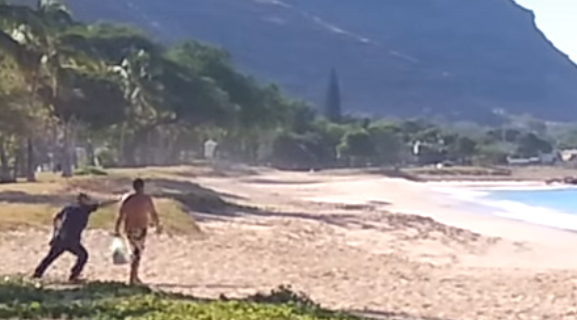
In a story that has received scant mainstream attention, a Hawaiian man was savagely beaten by a Honolulu Police Department officer in 2014 for offering a prayer to a monk seal; the entire (apparently unprovoked) assault was captured on cellphone video by a bystander.
On September 10, 2014, 41-year-old Jamie Kalani Rice was walking on Honolulu’s Nanakuli Beach when he came across a monk seal lying on the beach in apparent distress. Rice, who is Native Hawaiian, knelt several feet from the monk seal and began a prayer ritual which he later said was to offer the seal some of his mana; the ritual included chanting and rubbing himself with sand. Video shot by witnesses show that this ritual continued for several minutes, and Rice was seen occasionally lightly throwing small handfuls of sand at the seal to urge it back into the water; the seal only reacts at one point to the sand (minute 4:20 mark in the video, after the jump), but mostly appears non-responsive. Monk seals are a protected species, and Nanakuli Beach has signs warning visitors not to disturb these animals if they are encountered.
Soon, cellphone video shows Rice approached by Honolulu Police Department officer Ming Wang, and the two men exchange words. At the 7:45 minute mark, Wang removes his baton from his hip and flips it open, while Rice is still kneeling and engaged in prayer; Wang also appears to begin to shake his right hand up and down, which may have been the police offer preparing his can of pepper spray.
When the seal begins to move away from the two men, Rice gets up to leave and video shows Wang escorting him back to his belongings, baton still in hand. Although Rice shouts something unintelligible as he and Wang walk back down the beach, Rice appears non-violent and largely cooperative. Rice gathers his things and turns his back on Wang, walking away down the beach.
Suddenly, at the 9:30 mark of the video, the video takes a surreal turn. For no apparent reason, Wang runs up behind Rice and begins to spray him in the face with (what is likely) pepper spray, and swings his baton with full force using his left hand at a dazed Rice. Wang targets Rice’s shoulders and midsection, and then hits him on the left hand — causing Rice to drop his plastic bag. When Wang hits Rice in the knees using his baton, Rice drops to the ground and lies prone as Wang delivers a kick to his body. As the video ends, Wang places Rice in handcuffs.
At no point in the video does Rice appear to become physical towards Wang, or to resist the police officer. He does not appear to oppose a danger to Wang’s safety, which might justify the use of force against him. Instead, this appears to be a clear case of a police officer who approached a situation primed to use violence against a citizen in order to enforce compliace, who then engaged in excessive force for no justifiable reason.
Rice suffered a broken hand as a result of the attack, and he pleaded “no contest” to a misdemeanor charge of obstructing a government operation. Now, he is suing Officer Wang and HPD police chief Louis Kealoha for violation of his civil rights, assault and battery and false imprisonment related to the incident. Rice says that Wang beat him unjustifiably, and that he and others later falsified their reports to attempt to rationalize the use of force.
Although prosecutors initially declined to press charges against Wang for excessive police force, chief prosecutor Keith Keneshiro has just ordered a re-examination of the case in the wake of the civil lawsuit. According to Courthouse News, the results of an internal HPD investigation into Wang’s actions will not be made public unless Wang’s employment is terminated, and the police officer is still on duty with HPD.
Rice’s assault does not occur in a political vacuum; rather it exists within the larger context of Hawaiian colonialization, wherein Native Hawaiians find their culture, custom, language and religion disrespected on their own land by the American government that occupies it. We, non-Native Hawaiian Asian Americans whose history includes our ancestors being imported as labourers by the American government to work the islands’ plantations, must challenge how we (like police officer Wang Ming) can be complicit in this settler colonialism, particularly if we work actively to reinforce systems of mainstream power and privilege over other marginalized and indigenous people.
A year-long fight between Native Hawaiian activists over the proposed building of a telescope on Mauna Kea peak — sacred land for Native Hawaiian people — also underscores how the US government too often overlooks the interests and beliefs of Native Hawaiians, which leaves Native Hawaiians marginalized on their own soil. Similarly, Fusion recently reported that Hawaii has the highest homelessness rate per capita of any American state, and that the rate of unsheltered families living on the streets has risen 46% between 2014 and 2015; Native Hawaiians are overrepresented by nearly a factor of three among the state’s homeless population, and by a factor of four in the state’s incarcerated population. This ongoing trauma of marginalization, colonialization and cultural erasure of Native Hawaiians by our government goes largely unnoticed and unchallenged by those of us living on the mainland. Our silence only compounds that pain.
Last year, Native Hawaiians organized an historic vote to elect delegates who would convene later this year to draft documents for building sovereignty for Native Hawaiian peoples. After the election was challenged by other Native Hawaiians on the grounds that it was race-based, US courts blocked the counting of those ballots. However, the group organizing the conference plans to go ahead with the event anyways.
